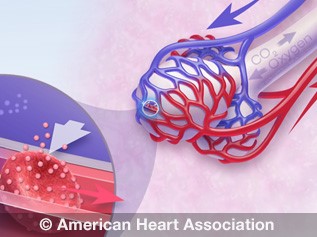Pulmonary Hypertension – High Blood Pressure in the Heart-to-Lung System
Quick Facts
- Pulmonary hypertension affects blood vessels in the lungs.
- It is different than high blood pressure of the blood vessels.
- Pulmonary hypertension can damage the heart and lead to heart failure.
What is pulmonary hypertension?
Pulmonary hypertension, or PH, is high blood pressure in the arteries that go to your lungs. PH is different than high blood pressure of the blood vessels.
Pulmonary blood pressure is the pressure the heart uses to pump blood from the heart through the arteries of the lungs.
Pulmonary blood pressure is normally a lot lower than regular blood pressure. Normal pulmonary artery pressure is 11-20 mm Hg at rest. If the pressure in the pulmonary artery is greater than these levels , it is abnormally high. This is called pulmonary hypertension. Pulmonary blood pressure is measured by a cardiac catheterization.
How blood flows through your heart and lungs
The lower right heart chamber of the heart is the right ventricle. It receives blood without oxygen and pumps it to your pulmonary arteries. The blood then travels to your lungs to get oxygen. Then the blood goes to the upper left heart chamber. This chamber is called the left atrium. The oxygen-rich blood moves into the lower left chamber called the left ventricle. The left ventricle pumps blood to the rest of your body through the aorta.
Watch how blood flows through your heart and lungs.
Long-term effects of pulmonary hypertension
High blood pressure can cause the heart to work harder to deliver blood to the body. In the same way, PH can occur when the arteries in the lungs narrow and thicken. The arteries resist the flow of blood through the pulmonary arteries to the lungs. As a result, the pressure in your arteries rises as your heart works harder to try to force the blood through. Heart failure occurs when the heart becomes too weak to pump enough blood to the lungs.
Signs and symptoms
Symptoms include:
- Shortness of breath with increased activity
- Fatigue
- Chest pain
- Racing heartbeat
- Pain in upper right side of stomach
- Decreased appetite
- Coughing and wheezing
- Feeling light-headed, especially during physical activity
- Fainting
- Swelling in the ankles or legs
Risk factors
Early signs and symptoms of PH are similar to those of many other medical conditions. For this reason, you may not notice them.
These factors can increase your risk of developing pulmonary hypertension.
- Age: Risk increases as you age.
- Environment: Exposure to Asbestos or certain infections caused by parasites
- Family history and genetics: A family history of blood clots and certain genetic disorders, such as Down syndrome, congenital heart disease and Gaucher disease
- Lifestyle: Unhealthy habits such as smoking and illegal drug use
- Medications: Some prescribed medications used to treat cancer and depression
- Sex: Pulmonary hypertension is more common in women than in men.
Medical evaluation
Your health care professional may recommend tests and procedures to diagnose PH and discern its cause and severity. Common tests include:
- Blood tests
- Echocardiograph (echo)
- Chest X-ray
- Electrocardiogram (ECG or EKG)
- Catheterization of the right side of the heart
Discovering the primary cause may involve further testing.
Factors that can affect pulmonary hypertension
Your health care professional will recommend the best management plan for you. You can live an active, fulfilling life by working with your health care professional to manage your symptoms.
- Talk to your health care professional before taking over-the-counter (OTC) medicine. Some OTC medicine can worsen symptoms of PHT or affect how prescriptions work.
- Ask whether you should get a pneumonia, flu, COVID or RSV vaccination.
- Pregnancy can create serious risks for women with PHT. Discuss birth control options with your health care professional.
Lifestyle changes that can improve your symptoms
Depending on the cause of your pulmonary hypertension, your health care professional may recommend healthy lifestyle changes. You can talk to your health care professional about the following ways to manage your symptoms:
- Quit smoking. Your health care professional can recommend programs and products to help.
- Follow a healthy diet. Eat:
- Variety of fruits and vegetables
- Whole grains
- Plant-based proteins
- Lean meat
- Poultry
- Fish
- Fat-free or low-fat dairy products.
Your diet should be low in:
- Saturated fat
- Trans fats
- Sodium
- Added sugars
- Watch your weight. Keep a daily record of your weight so you can be aware of rapid weight gain. Rapid weight gain may be a sign that your PHT is getting worse.
- Stay active. Include physical activity such as brisk walking in your life. Talk about your activity level with your health care professional. Avoid straining or lifting heavy weights. Rest when you need to.
- Be careful about air travel and high-altitude locations. You may need to travel with extra oxygen. Discuss any travel plans with your health care professional.
Get support to help you manage the anxiety and stress of living with PH. Ask your health care professional for a referral to a counselor. Look for a support group for people living with PH.






